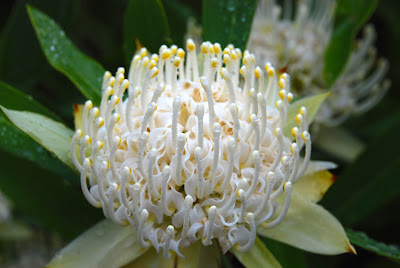The Australian Garden
It is very rare to see Sturt's Desert Pea growing in red sand in Victoria. But if you venture into the Australian Garden at the Royal Botanic Gardens in Cranbourne, you may see this wonderful desert plant growing happily in
Victoria's cool and wet climate.
 |
| Swainsona formosa |
The Red Sand Garden is at the heart of the Australian Garden. It has been designed to mimic the shapes and colours of the Australian Outback. Wild flowers and salt bush have been planted here to show the seasonal flush of growth of
plants from the desert centre of Australia.
The circular vibrant Red Sand Garden is surrounded by a number of different
gardens and displays aimed at bringing the beauty and diversity of Australian
plants and landscapes to the public.
We followed the paths that lead us through these wonderful gardens. Walking around the Red Centre, we came upon a stream bubbling water to the surface of the parched landscape. Where water flows, plants grow. The Waterway is lined with the Smooth-barked Apple Gum, Dwarf Lilly Pillies, and Guinea Flowers.
The very tall red flower on the spike is a Gymea Lilly.
Those flower spikes can grow 4 meters tall!
Also flowering well this season were blue watering cans,
yellow watering cans,
and of course the red flowering variety of watering cans.
These watering cans have been used to highlight differing watering needs and drought tolerance of the different plants in the Water Saving Gardens. This system highlight to home gardeners that not all Australian plants need a lot of water. Plants growing near the red watering cans hardly need any water at all!
Many displays show how the diversity of texture and colour of Australian plants can be used in the home garden. Here, Kangaroo Paw with it's strappy, upright leaves, provides a strong textural back drop to low growing shrub that is in full bloom. A striking contrast.
 |
| Wade between the flags |
The Escarpment Wall and the Rockpool Waterway reflect the many waterways and escarpments such as Kings Canyon and Palm Valley found in Central Australia.
No one feel in and got wet today.
 |
| No kids today, too wet! |
Remember playing in your back yard as a child. Back yards are almost a thing of the past as houses get larger and blocks get smaller. Here is a garden designed just for children.
Mind you this structure would be hard to fit in any ones back yard!
 |
| Please excuse the rain drops on the lens |
The view backup the Rockpool Waterway.
The following two photos are of Waratahs in full bloom. The Waratah belongs to the Telopea family and generally grow as large shrubs or small trees. They are very popular with home gardeners for their very showy display of flowers during Spring.
 |
| White Telopea |
The red Waratah (Telopea speciosissima) is the floral emblem of New South Wales. The name waratah comes from the Eora people who originally inhabited the Sydney area.
 |
| Red waratah |
We continued along the path as it snaked it's way through the garden. The undulating landscape provided different views and perspectives of the gardens.
As it was such a grey day and with rain drops all over the camera lens,
the above photo does not do justice to the view.
So here is a photo of the same view that was prepared earlier.
And here is a closer up photo of the same view.
There are over 700 species of Eucalyptus trees in Australia.
Quite a few of them have been planted in these gardens.
The Eucalyptus Walk features some of the most well known Eucalypt species including ironbark, box, peppermint, blood wood and stringybark.
The Eucalyptus Walk also features the red flowering wattle (Acacia leprosa), the orange flowering Banksia burdettii, two prehistoric cycads and
some ancient Grass-trees.
The Grass-trees, Xanthorrhoea johnsonii, are hundreds of years old
and are currently in flower!
The tall flowering spikes were prominent against the grey sky.
So were the birds fluttering up and down along the flower spikes
feeding on the sweet nectar.
 |
| Purple and green minty haze. |
The above photo shows a hedge made from Prostanthera or Mint Bush. Brushing up against the hedge or rubbing the leaves with between your finger releases
a strong, fresh minty aroma. So refreshing!
And so our tour of the Australian Gardens came to an end.
Even though it was such a grey day, it was still a fantastic experience wandering
through the Gardens in the light rain.
So I will leave you with a few photos taken on a bright sunny day
from earlier this Spring.
The Visitor Centre and cafe is a great place to sit and relax. This little ring-tailed possum has also made itself at home in between the shutters and the window overlooking the cafe.
We enjoyed watching the possum sleep while we sipped on
lattes and chatted about our day's grand tour of the
Royal Botanic Gardens in Cranbourne.
We enjoyed watching the possum sleep while we sipped on
lattes and chatted about our day's grand tour of the
Royal Botanic Gardens in Cranbourne.
The Australian Garden is expanding!
The second stage of the Gardens is opening on the 21st & 22nd of October 2012.
What a good excuse to come and visit this magnificent collection and display
of Australian flora!
For more information about the Australian Garden click here.
And here is a link to a map of the Australian Garden.
Walkabouters Club of Victoria Inc.
A0019863A















































